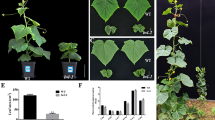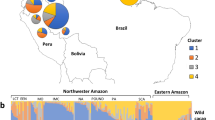Abstract
The metabolic precursor of vitamin A, β-carotene, is essential for human health. The gene(s) controlling β-carotene quantity (QβC) has been introgressed from Xishuangbanna gourd (XIS, possessing β-carotene; Cucumis sativus L. var. xishuangbannanesis Qi et Yuan; 2n = 2x = 14) into cultivated cucumber (no β-carotene; Cucumis sativus L.). To determine the inheritance of QβC in cucumber fruit endocarp, F1 progeny and a set of 124 F7 recombinant inbred lines (RILs) derived from the cultivated cucumber line CC3 and XIS line SWCC8 were evaluated for QβC during 2009 and 2010 in Nanjing, China. Segregation analysis revealed that endocarp QβC of greenhouse-grown fruit was controlled by a single recessive gene. Further, marker analysis indicated the gene controlling QβC was linked to seven SSR markers on linkage group 3, where their order was SSR20710–SSR19511–SSR15419–SSR07706–ore–SSR23231–SSR11633–SSR20270. These markers and the putative candidate gene were mapped to cucumber chromosome 3DS. An evaluation of 30 genetically diverse cucumber lines indicated that marker SSR07706 has utility in further genetic analyses of the QβC orange endocarp gene, designated ore. Moreover, the markers defined herein may have utility for marker-assisted selection directed towards the development of cucumber germplasm with high fruit β-carotene content.




Similar content being viewed by others
References
Bohn M, Groh S, Khairallah MM, Hoisington DA, Utz HF, Melchinger AE (2001) Re-evaluation of the prospects of marker-assisted selection for improving insect resistance against Diatraea spp. in tropical maize by cross validation and independent validation. Theor Appl Genet 103:1059–1067
Charters YM, Robertson A, Wilkinson MJ, Ramsay G (1996) PCR analysis of oilseed rape cultivars (Brassic napus L.ssp. oleifera) using 50-anchored simple sequence repeat (SSR) primers. Theor Appl Genet 92:442–447
Chen JF, Zhang SL, Zhang XG (1994) The xishuangbanna gourd (Cucumis sativus var. xishuangbananesis Qi et Yuan), a traditionally cultivated plant of the Hanai people, Xishuangbanna, Yunnan, China. Cucurbit Genetics Cooperative Report 17:18–20
Clark MS (1997) Plant molecular biology: a laboratory manual. Springer, Berlin
Clayberg CD (1992) Interaction and linkage test of flesh color genes in Cucumis melo L. Cucurbit Genet Coop Rep 15:53
Cuevas HE, Staub JE, Simon PW, Zalapa JE, McCreight JD (2008) Mapping of genetic loci that regulated quantity of β-carotene in fruit of US Western Shipping melon (Cucumis melo L.). Theor Appl Genet 117:1345–1359
Cuevas HE, Staub JE, Simon PW, Zalapa JE (2009) A consensus linkage map identifies genomic regions controlling fruit maturity and beta-carotene-associated flesh color in melon (Cucumis melo L.). Theor Appl Genet 119:741–756
Cuevas HE, Song H, Staub JE, Simon PW (2010) Inheritance of beta-carotene-associated flesh color in cucumber (Cucumis sativus L.) fruit. Euphytica 171:301–311
Davies J, Berzonsky WA, Leach GD (2006) A comparison of marker-assisted and phenotypic selection for high grain protein content in spring wheat. Euphytica 152:117–134
Davuluri GR, Tuinen AV, Fraser PD, Manfredonia A, Newman R, Burgess D, Brummell DA, King SR, Palys J, Uhlig J, Bramley PM, Pennings HMJ, Bowler C (2005) Fruit-specific RNAi-mediated suppression of DET1 enhances carotenoid and flavonoid content in tomatoes. Nat Biotechnol 23:890–895
Eathington SR, Dudley JW, Rufener GK (1997) Usefulness of marker-QTL associations in early generation selection. Crop Sci 37:1686–1693
Fan ZC, Robbins MD, Staub JE (2006) Population development by phenotypic selection with subsequent marker-assisted selection for line extraction in cucumber (Cucumis sativus L.). Theor Appl Genet 112:843–855
Fazio G, Staub JE (2003) Comparative analysis of response to phenotypic and marker-assisted selection for multiple lateral branching incucumber (Cucumis sativus L.). Theor Appl Genet 107:875–883
Fazio G, Staub JE, Chung SM (2002) Development and characterization of PCR markers in cucumber (Cucumis sativus L.). J Am Soc Hort Sci 127:545–557
Fazio G, Staub JE, Stevens MR (2003) Genetic mapping and QTL analysis of horticultural traits in cucumber (Cucumis sativus L.) using recombinant inbred lines. Theor Appl Genet 107:864–874
Fraser PD, Bramley PM (2004) The biosynthesis and nutritional uses of carotenoids. Progr Lipid Res 43:228–265
Fulton TM, Grandillo S, Beck-Bunn T, Fridman E, Frampton A, Loper J, Petiard V, Uhlig J, Zamir D, Tanksley SD (2000) Advanced backcross QTL analysis of Lycopersicon esculentum × Lycopersicum parvixorum cross. Theor Appl Genet 100:1025–1042
Graham RD, Welch RM, Bouis HE (2001) Addressing micronutrient malnutrition through enhancing the nutritional quality of staple foods: Principles, perspectives and knowledge gaps. Adv Agron 70:77–142
Harjes CE, Rocheford TR, Bai L, Brutnell TP, Kandianis CB, Sowinski SG, Stapleton AE, Vallabhaneni R, Williams M, Wurtzel ET, Yan JB, Buckler ES (2008) Natural genetic variation in lycopene epsilon cyclase tapped for maize biofortification. Science 319:330–333
Just BJ, Santos CAF, Fonseca MEN, Boiteux LS, Oloizia BB, Simon PW (2007) Carotenoid biosynthesis structural genes in carrots (Daucus carota): isolation, sequence characterization, single nucleotide polymorphism (SNP) markers and genome mapping. Theor Appl Genet 114:693–704
Kandlakunta B, Rajendran A, Thingnganing L (2008) Carotene content of some common (cereals, pulses, vegetables, spices and condiments) and unconventional sources of plant origin. Food Chem 106:85–89
Katzir N, Danin-Poleg Y, Tzuri G, Karchi Z, Lavi U, Cregan PB (1996) Length polymorphism and homologies of microsatellites in several Cucurbitaceae species. Theor Appl Genet 93:1282–1290
Kosambi DD (1944) The estimation of map distances from recombination values. Ann Eugen 12:172–175
Lincoln SE, Daly MJ, Lander ES (1993) Constructing linkage maps with MAPMAKER/Exp Version 3.0. A tutorial reference manual, 3rd edn. Whitehead Institute for Medical Res, Cambridge
Lu S, Van Eck J, Zhou X, Lopez AB, O’Halloran M, Cosman KM, Conlin BJ, Paolillo DJ, Garvin DF, Vrebalov J, Kochian LV, Küpper H, Earle ED, Cao J, Li L (2006) The cauliflower Or gene encodes a DNA-J cysteine-rich domain-containing protein that mediates high levels of β-carotene accumulation. Plant Cell 18:3594–3605
Mares-Perlman JA, Millen AE, Ficek TL, Hankinson SE (2002) The body of evidence to support a protective role for lutein and zeaxanthin in delaying chronic disease. J Nutr 132:518S–524S
Michelmore RM, Paran I, Kesseli RV (1991) Identification of markers linked to disease-resistance genes by bulked segregant analysis: a rapid method to detect markers in specific genomic regions by using segregating populations. Proc Natl Acad Sci USA 88:9828–9832
Navazio JP (1994) Utilization of high carotene cucumber germplasm for genetic improvement of nutritional quality. Ph.D. Thesis, University of Wisconsin-Madison
Navazio JP, Simon PW (2001) Diallel analysis of high carotenoid content in cucumbers. J Am Soc Hort Sci 126:100–104
Pozniak CJ, Knox RE, Clarke FR, Clarke JM (2007) Identification of QTL and association of a phytoene synthase gene with endosperm colour in durum wheat. Theor Appl Genet 114:525–537
Qi CZ, Yuan ZZ, Li YX (1983) A new type of cucumber—Xishuangbanna cucumber. Acta Hort Sin 10:259–264
Ren Y, Zhang ZH, Liu JH, Staub JE, Han YH, Cheng ZC, Li XF, Lu JY, Miao H, Kang HX, Xie BY, Gu XF, Wang XW, Du YC, Jin WW, Huang SW (2009) An integrated genetic and cytogenetic map of the cucumber genome. PLoS One 4:e5795
Robbins MD, Staub JE (2009) Comparative analysis of marker-assisted and phenotypic selection for yield components in cucumber. Theor Appl Genet 119:621–634
Robbins MD, Casler M, Staub JE (2008) Pyramiding QTL for multiple lateral branching in cucumber using nearly isogenic lines. Mol Breed 22:131–139
Royal Horticultural Society (2005) The Royal Horticultural Society colour chart. The Royal Horticultural Society, London
Santos CAF, Simon PW (2002) QTL analyses reveal clustered loci for accumulation of major provitamin A carotenes and lycopene in carrots roots. Mol Genet Genomics 268:122–129
Simon PW (1992) Genetic improvement of vegetable carotene content. In: Bills DD, Kung S-D (eds) Biotechnology and nutrition. Proceedings of the 3rd international symposium. Butterworth-Heinemann, Boston, pp 291–300
Simon PW, Navazio JP (1997) Early orange mass 400, early orange mass 402, and late orange mass 404: high-carotene cucumber germplasm. HortScience 32:144–145
Simon PW, Wolff XY (1987) Carotenes in typical and dark orange carrots. J Agric Food Chem 35:1017–1022
Staub JE, Sun Z, Chung SM, Lower RL (2007) Evidence for colinearity among genetic linkage maps in cucumber. Hort Sci 42:20–27
Tanksley SD (1983) Molecular markers in plant breeding. Plant Mol Biol Rep 1:3–8
Underwood BA (2004) Vitamin A deficiency disorders: international efforts to control a preventable “Pox”. J Nutr 134:231S–236S
Wong JC, Lambert RJ, Wurtzel ET, Roncherford TJ (2004) QTL and candidate genes phytoene synthase and ζ-carotene desaturase associated with the accumulation of carotenoids in maize. Theor Appl Genet 108:349–359
Yang SL, Pu H, Liu PY, Walters TW (1991) Preliminary studies on Cucumis sativus var. xishuangbannanesis. Cucurbit Genet Coop Rep 14:29–31
Acknowledgments
The work was supported by the National Natural Science Foundation of China (30972007), Science and Technology Infrastructure Construction Project of Jiangsu Province of China (BM2008008), and State Key Laboratory of Crop Genetics and Germplasm Enhancement, Nanjing agricultural university, China, and Key Laboratory of Southern Vegetable Crop Genetic Improvement.
Author information
Authors and Affiliations
Corresponding author
Electronic supplementary material
Below is the link to the electronic supplementary material.
Rights and permissions
About this article
Cite this article
Bo, K., Song, H., Shen, J. et al. Inheritance and mapping of the ore gene controlling the quantity of β-carotene in cucumber (Cucumis sativus L.) endocarp. Mol Breeding 30, 335–344 (2012). https://doi.org/10.1007/s11032-011-9624-4
Received:
Accepted:
Published:
Issue Date:
DOI: https://doi.org/10.1007/s11032-011-9624-4




